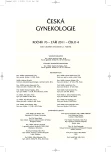Is it necessary to revise the guidelines on prevention of thrombembolic disease in pregnancy?
Authors:
T. Binder
Authors‘ workplace:
Gynekologicko-porodnická klinika 2. LF UK a FN Motol, Praha, přednosta prof. MUDr. L. Rob, CSc.
Published in:
Ceska Gynekol 2011; 76(4): 316-320
Overview
Aim of the study:
Analysis of the issue of thrombembolic complications in pregnant women.
Type of the study:
Current concepts review.
Setting:
Department of Obstetrics and Gynecology 2nd Medical Faculty of Charles University and Teaching Hospital Motol, Prague.
Methods:
Analysis of practical implementation of the guideline on the thrombembolic complication prevention during pregnancy. Notes on individual conditions and situations from the viewpoint of thrombembolic complication risk, using “evidence based medicine”. Comparison of the Czech and Anglo-American guidelines.
Conclusions:
There is no general consensus on implementation of the guideline on thrombembolism prevention in pregnant women in the Czech Republic and many mistakes may be found in this respect. Although the issue falls primarily into the competence of haematologists, there is a number of situations that must be resolved by the obstetrician.
Key words:
thrombembolic disease prevention, pregnancy.
Sources
1. Bates, SM., Greer, IA., Hirsh, J., Ginsberg, JS. Use of Antithrombotic Agents During Pregnancy. The Seventh ACCP Conference on Antithrombotic and Thrombolytic Therapy; Evidence Based Guidelines; http//hestjournal.chestpubs.org/content/126/ 3_suppl/627S.full 2004.
2. Bates, SM., Greer, IA., Pabinger, I., et al. Venous thrombembolism, thrombophilia, antithrombic therapy, and pregnancy: American College of Chest Physicians Evidence Based Clinical Practice Guidelines. 8th Ed. Chest, 2008, 133 (6 Suppl), p. 844S‑886S.
3. Bounameaux, H., De Moerloose, P. Is laboratory monitoring of low-molecular-weigh heparin therapy necessary? J Thromb Haemost, 2004, 2, p. 551-554.
4. Greaves, M. Limitations of the laboratory monitoring of heparin therapy. Thromb Haemost, 2002, 87, p. 163-164.
5. O’Connor, DJ., Scher, LA., Gargiulo, NJ 3rd, et al. Incidence and characteristics of venous thromboembolic disease during pregnancy and the postanatal period: a contemporary series. Ann Vasc Surg, 2010, 26.
6. Penka, M., Binder, T., Unzeitig, V., Dulíček, P. Návrh antitrombotické profylaxe a péče o trombofilní stavy v gynekologii a porodnictví – doporučený postup. Čes Gynek 2010, 75, (S1), s. 23-25.
7. Royal College of Obstetricians and Gynaecologist. Thromboprophylaxis During Pregnancy, Labour and After vaginal Delivery, RCOG Guideline No.37, 2004.
8. Sephton, V., Farquharson, RG., Topping, J., et al. A longitudinal study of maternal dose- response to low mlecular weight heparin in pregnancy. Obstet Gynecol, 2003, 101, p. 1307-1311.
Labels
Paediatric gynaecology Gynaecology and obstetrics Reproduction medicineArticle was published in
Czech Gynaecology

2011 Issue 4
Most read in this issue
- Fetal tricuspid regurgitation
- Application of SNP array method in prenatal diagnosis
- Transabdominal ultrasound examination in gynecology
- Current classification of malignant tumours in gynecological oncology – part I
